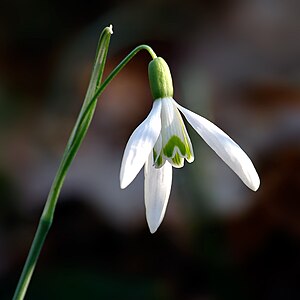Galanthus nivalis
| Common snowdrop | |
|---|---|
 |
The common snowdrop (Galanthus nivalis) is the best-known representative of a small genus of about 20 species in the family Amaryllidaceae that are among the first bulbs to bloom in spring.
Description
[edit | edit source]Growing conditions
[edit | edit source]Varieties
[edit | edit source]Single flowered
[edit | edit source]- Galanthus nivalis Poculiformis Group - inner segments are almost same length and shape as outer ones, usually unmarked and without a "sinus" (notch); includes such cultivars as 'Sandhill Gate'
- Galanthus nivalis Sandersii Group - marks on inner segments are yellow instead of green; includes 'Sandersii' and 'Lutescens'
- G. nivalis Scharlockii Group - "donkey's ears snowdrop" with elongated spathe split down center, resembling upright ears
Double-flowered
[edit | edit source]- G. nivalis f. pleniflorus 'Blewbury Tart' - upward- or outward-facing flowers with dark green markings in the center
- G. nivalis f. pleniflorus 'Flore Pleno' - doubles, usually quite untidy rosettes of extra segments of uneven length
- G. nivalis f. pleniflorus 'Lady Elphinstone' - a version of 'Flore Pleno' with yellowish coloring inside the flowers instead of green; may revert or vary from year to year
- G. nivalis f. pleniflorus 'Pusey Green Tip' - with small green tips to the outer segments
Double-flowered forms such as Galanthus nivalis f. pleniflorus 'Flore Pleno' may be less attractive to the eye of the purist. There are numerous cultivars (cultivated varieties), single and double, differing particularly in the size and markings of the flower, the period of flowering, and other characteristics of interest to keen (even fanatical) collectors known as "galanthophiles".
Other notable species:
- Crimean snowdrop, Galanthus plicatus, 30 cm tall, flowering January/March, white flowers, with broad leaves folded back at the edges
- Giant snowdrop, Galanthus elwesii, a native of the Levant, 23 cm tall, flowering January/February, with large flowers, the three inner segments of which often have a much larger and more conspicuous green blotch (or blotches) than the more common kinds.
Uses
[edit | edit source]Maintenance
[edit | edit source]Propagation
[edit | edit source]Propagation is by offsets removed when the plants are at rest, immediately after the leaves have withered; or by seeds sown either when ripe, or in spring. Professional growers and keen amateurs also use such methods as "twin-scaling" to increase the stock of choice varieties quickly.
Harvesting
[edit | edit source]Pests and diseases
[edit | edit source]References
[edit | edit source]| Wikiversity is collecting bloom time data for Galanthus nivalis on the Bloom Clock |